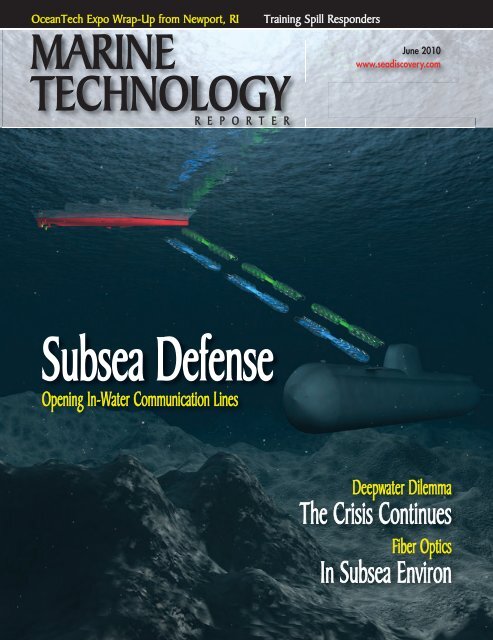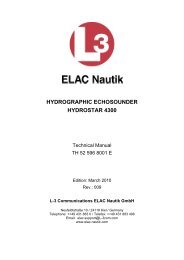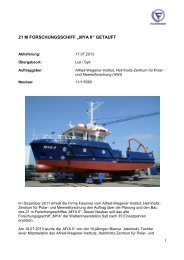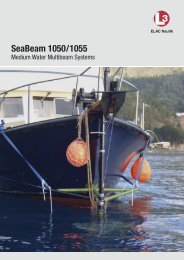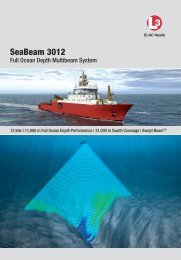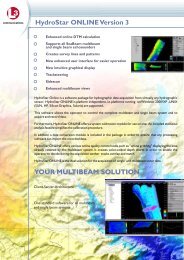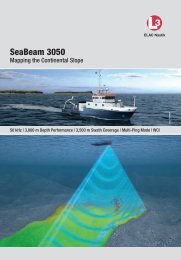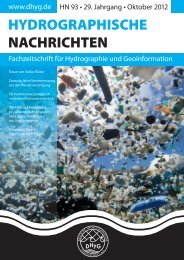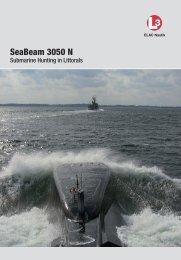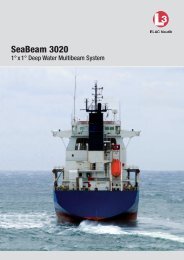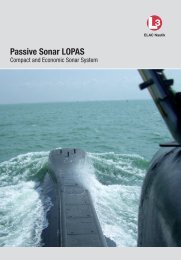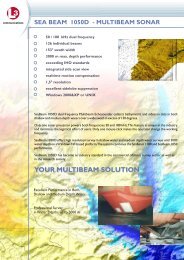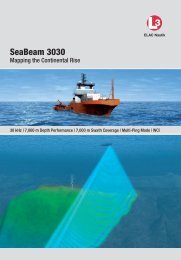MARINE TECHNOLOGY - Elac-Nautik
MARINE TECHNOLOGY - Elac-Nautik
MARINE TECHNOLOGY - Elac-Nautik
Create successful ePaper yourself
Turn your PDF publications into a flip-book with our unique Google optimized e-Paper software.
OceanTech Expo Wrap-Up from Newport, RI Training Spill Responders<br />
<strong>MARINE</strong><br />
<strong>TECHNOLOGY</strong><br />
R E P O R T E R<br />
June 2010<br />
www.seadiscovery.com<br />
Subsea Defense<br />
Opening In-Water Communication Lines<br />
Deepwater Dilemma<br />
The Crisis Continues<br />
Fiber Optics<br />
In Subsea Environ
Reprinted from the June 2010 Edition of Marine Technology Reporter<br />
Faster, more secure and more precise<br />
Digital Underwater Telephones<br />
by Edward Lundquist<br />
Subsea Defense & Underwater Communication<br />
Ulrike Schulte-Rahde of L-3 ELAC <strong>Nautik</strong> in Kiel, Germany,<br />
says her company’s UT3000 Underwater Communication System<br />
can be used as secure interrogation system, similar to IFF<br />
(Identification Friend or Foe) used for aircraft.<br />
“The IFS (Identification of friendly submarines) system can<br />
secure identification of friendly submarines to ensure they are not<br />
identified as hostile combatants. It must be secure, robust, and<br />
able to operate at long ranges in all environments. IFS must be<br />
covert so that the friendly submarines would not reveal themselves<br />
to the enemy. With a defensible Low Probability of Intercept<br />
(LPI), only friendly units who have the capability to detect and<br />
decode such a signal will recognize the interrogated one,” she says.<br />
“This is vital for secure communications between submarines and<br />
other submarines, ships, AUVs, helicopters with dipping sonars or<br />
other vehicles and shore or seafloor stations.”<br />
With the UT3000, call signs, position information and other<br />
sensitive data are sent digitally and may even be encrypted. The<br />
system uses a projector and hydrophone receiver, and includes a<br />
human interface (HMI) graphic display and keyboard.<br />
Schulte-Rahde says the UT3000 can send four different types of<br />
messages in IFS mode:<br />
• Interrogation message (‘int’)<br />
• Reply message (‘rep’)<br />
• Do Not Answer message (‘dna’)<br />
• Emergency message (‘sos’)<br />
Depending on the selected transducer configuration, the multifunctional<br />
UT 3000 can be used in different modes, based upon<br />
the chosen modulation and the environmental conditions to offer<br />
analogue telephony and digital data transfer rates up to 3840bps,<br />
as well as a large number of additional optional functions in a wide<br />
and long-range robust data rate (LDR) (up to 90 bps) in variable<br />
frequency ranges. Schulte-Rahde says that the output power and<br />
frequency is adjustable so that it can even be used to communicate<br />
with divers as well as other vessels, and can be either directional or<br />
omni-directional.<br />
Gerald Baden, director marketing and sales for L-3<br />
Communications ELAC <strong>Nautik</strong> says new advances in digital<br />
underwater communications transcends sending simple messages,<br />
but secure identification, as well. In much the same way as<br />
transponders on friendly aircraft “squawk” when interrogated by<br />
Identification Friend or Foe (IFF), the IFS system can verify the<br />
presence of a friendly underwater contact. “IFS currently being<br />
integrated as a function into the UT3000. IFS is only possible<br />
with digital communications.”<br />
IFS is presently a study carried out together with the COE CSW<br />
(Center of Excellence for coastal and shallow waters and the<br />
Research Branch for Waterborne Sound and Geophysics (FWG),<br />
a Division within the Bundeswehr Technical Center for Ships and<br />
Naval Weapons, Maritime Technology and Research, according to<br />
Kai Duehrkop, L-3 ELAC Nautic’s manager of marketing and<br />
sales. “The primary mode is manual. A signal is only sent at the<br />
discretion of the submarine commander. The secondary mode is<br />
automatic, which can be used for unmanned underwater vehicles,<br />
gateway buoys and underwater stations.”<br />
The data can actually be transmitted so that it “hides” within the<br />
ambient noise in the water by spreading the signal energy over the<br />
frequency band over time using an algorithm known to friendly<br />
forces. To compromise the exchange, the enemy would need that<br />
algorithm as well. “That’s something you can’t do can’t do with<br />
analog,” says Baden<br />
Analog underwater communications are bound to certain modulation<br />
on a specific frequency. “You have all the problems and<br />
limitations you have with voice communications. When giving<br />
position data you have to repeat yourself. You can’t distribute<br />
complex information,” Baden says.<br />
Non Coherent Modulation Scheme<br />
To “hide” the transmission, Schulte-Rahde says a non coherent<br />
modulation scheme is used. “Non coherent modulation means in<br />
general that digital information is transmitted through discrete frequency<br />
changes of a carrier wave. The simplest non coherent modulation<br />
scheme is the binary FSK (frequency shift key), that<br />
implies using one discrete frequency to transmit binary (0 and 1)<br />
information. The detector tries to find out, if the carrier is set (->1<br />
is transmitted) or not (->0 is transmitted).”<br />
“Multiple frequency-shift keying (MFSK) applied in the UT<br />
3000 is a variation of FSK that uses more than one frequency, distributed<br />
over the transmission band. The principles in detection<br />
and evaluation are nearly the same,” Schulte-Rahde says. “The<br />
data rate increases with the amount of carriers you take within one<br />
transmitted symbol.”<br />
“The data rate with digital communications is relatively high,<br />
according to Baden, about 3,800 bits per second. It’s faster and<br />
more precise than voice,” he says. “It takes about 30 seconds to<br />
give a position report using an underwater telephone in the analog<br />
voice mode, and that can be garbled. Using digital, it takes less<br />
time with less ambiguity. There is no need to repeat, and it is<br />
harder to intercept.”<br />
All kind of digital data can be sent, including ASCII and binary,<br />
which is a totally new approach in underwater comms. This<br />
includes complex data gathered by autonomous underwater vehicles.<br />
“It is possible to send a plot of the surface situation, target
Reprinted from the June 2010 Edition of Marine Technology Reporter<br />
Subsea Defense & Underwater Communication<br />
information and all other info down to a submarine at speed and<br />
depth (or vice versa), and done so encrypted,“ Schulte-Rahde says.<br />
Baden says ELAC <strong>Nautik</strong>’s systems are found on virtually all conventional<br />
subs world wide.<br />
The UT 12 underwater telephone is still found on some submarines.<br />
The UT2000 analog system has been in use for 15 years<br />
and is found on many submarines around the world. The latest<br />
UT3000 model was introduced three years ago.<br />
“The UT3000 can replace the 2000. They are able to work with<br />
the same transducers. All that is required is an exchange of the<br />
main unit.”<br />
The system employs open architecture, according to Duehrkop.<br />
It is easy to update the software with new functions, or to customize<br />
the system, such as a customer wanting to install his own<br />
encryption.<br />
Because the system can monitor the full frequency range from 1<br />
to 60 khz, including upper and lower sidebands, it has the ability<br />
to intercept transmissions, such as a hostile sub trying to contact<br />
the surface.<br />
“This is all new,” says Baden. “We’re finding new applications<br />
every day.”


